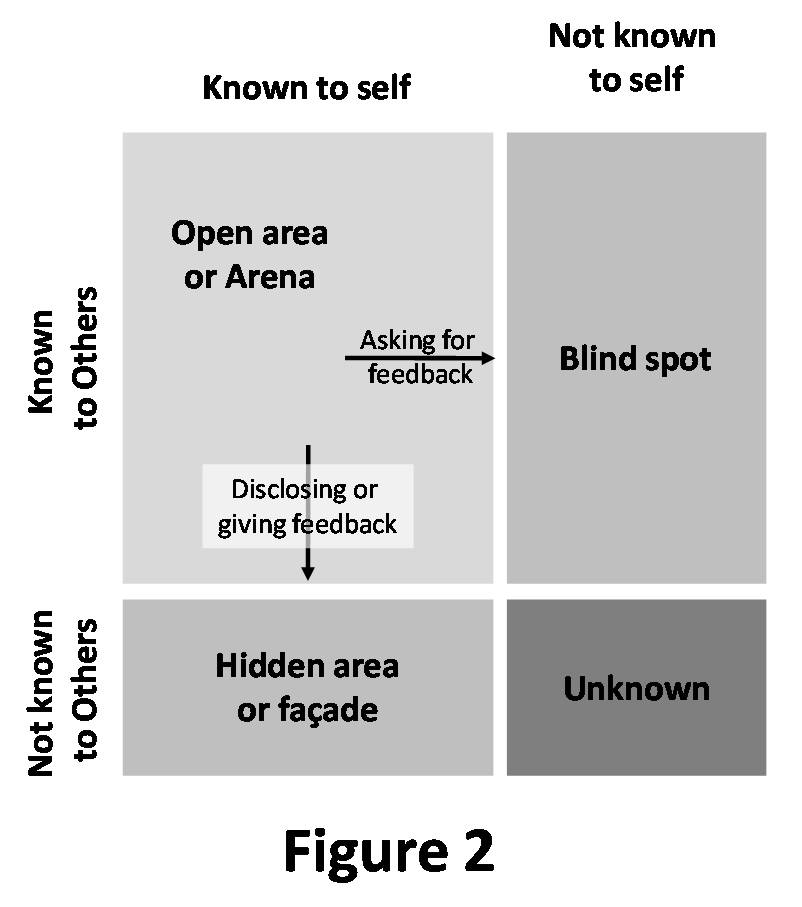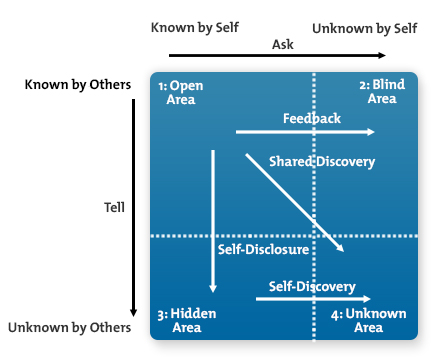Lesson 2: Psychosocial Causes of Abnormal Behaviour
The Johari Window
Figure 2.1: The Johari Window

 The Open Self quadrant represents things that people know about themselves and that others also know about them. For example, most people know the name of their parents (as do the parents themselves). A person may even know his or her parents’ favourite music, food, or movies. In addition to facts and interests, the open window can include feelings, behaviours, wants, needs, and desires – in fact, any information that a person is willing to share.
The Open Self quadrant represents things that people know about themselves and that others also know about them. For example, most people know the name of their parents (as do the parents themselves). A person may even know his or her parents’ favourite music, food, or movies. In addition to facts and interests, the open window can include feelings, behaviours, wants, needs, and desires – in fact, any information that a person is willing to share.
When a person first meets someone new, the size of the open window or quadrant may be small. This may be due to personal preference about withholding information or a lack of time to exchange information. As the process of getting to know one another continues, the “window shades” may move down or to the right, placing more information into the open window.
The Blind Self quadrant represents things that someone knows about another person that the person is unaware of. For example, if your friend walks out of a public washroom and has toilet paper hanging from the back of his shoe, he may not know it. This information is in his blind quadrant because you can see it and but he cannot. If you tell your friend that he has toilet paper on his shoe, the window shade moves to the right enlarging the open quadrant’s area. This is an example of a simple issue. More complex issues may result in functional problems. For instance, people may not realize that they tend to avoid eye contact when interacting with authority figures. This could place them in awkward positions when developing trust relationships with employers, police officers, etc., especially in North America where the culture interprets avoidance of eye contact as suspicious.
The Hidden Self quadrant represents things that people know about themselves that they do not want others to know  about. For example, Charlie may not want to tell his friends that he is afraid of the dark. This information would be in his hidden quadrant. As soon as he tells his friends that he is afraid of the dark, he is moving the information from the hidden quadrant into the open quadrant.
about. For example, Charlie may not want to tell his friends that he is afraid of the dark. This information would be in his hidden quadrant. As soon as he tells his friends that he is afraid of the dark, he is moving the information from the hidden quadrant into the open quadrant.
The Unknown Self quadrant represents things that neither people know about themselves nor their friends know about them. For example, Maria may discuss with a friend a dream that she had. As they try to understand the meaning of the dream, a new awareness may become apparent, known to neither of them before the discussion. When people are placed in novel situations, they may learn information about themselves that they did not realize before. Sometimes this newfound knowledge is liberating or positive, and other times the information is debilitating or negative.
As a person’s level of confidence and self-esteem improves, he or she may ask for others to comment on his or her blind spots. A priest, for example, may seek feedback from his congregation on the quality of a particular sermon with the desire of improving his presentation. At other times, however, people may avoid sharing parts of themselves with others – the parts that would make them vulnerable.
Video: The Johari Window Model
Many people have subconscious beliefs and motivations that may reflect feelings of inadequacy, incompetence, impotence, unworthiness, rejection, guilt, dependency, etc. that may be difficult for them to confront consciously – any of which may be obvious to others. To help cope with subconscious feelings, people may employ a variety of defence mechanisms such as denial, projection, rationalization, regression, repression, and sublimation. Many people tend to cling to existing assumptions and reject or distort new information that is contradictory to their cognitive outlook. Changing one’s existing framework to incorporate conflicting information is a challenge. When a change does occur, this accommodation can be painful and time-consuming. If accommodation does not occur, however, a person may become vulnerable to disorder.
As children develop, they acquire various skills. They learn strategies for categorizing information, they employ coping mechanisms, and they develop preferences and dislikes -- many of which continue into their adult lives. The approach to life that children develop is further shaped during adulthood. How well children are able to integrate new information and learning styles affects their adult behaviour. In an ideal world, the environment of childhood through to adulthood should include the following:
a) Comprehension and/or understanding, order, and predictability. Unless we can see order and predictability in our environment, we cannot determine intelligent responses to events. The rules and customs of society reflect this need for order and understanding.
b) Adequacy, capability, and security. Adults and children alike need to feel that they are competent people. Feeling inadequate reduces coping ability and increases insecurity.
c) Love, belonging, and approval. All individuals need to love and be loved. Even if other basic needs are lacking (e.g., extreme poverty), a child raised in a loving home can overcome the deficiency of many things.
d) Self-esteem, worth, and uniqueness. Linked closely to adequacy, people need to feel worthy of respect from others.
e) Values, meaning, and hope. Feelings of futility and apathy may develop without a measure of value and meaning to life.
f) Personal growth and fulfillment. The ability to increase personal satisfaction by using skills, potential, and knowledge in creative ways influences our motivational structure and enhances physical and psychological well-being.